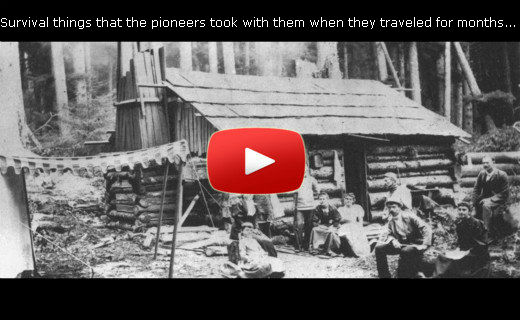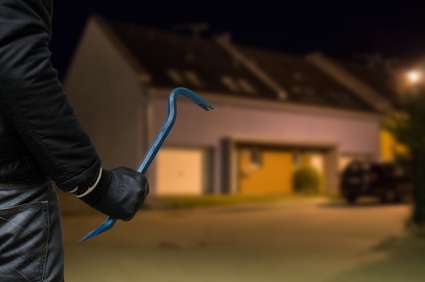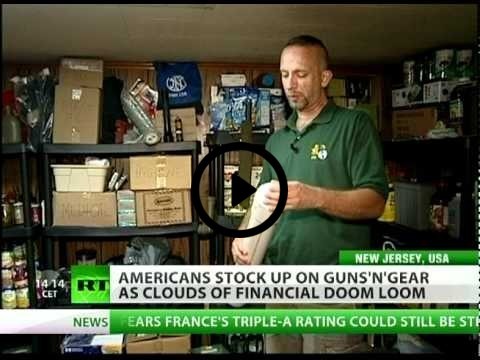The Six Enemies of Your Doomsday Stockpile
Looters, infected rodents, and worse –The enemies of your stockpile have been around for thousands of years, and destroyed more food than one could possibly estimate.
Meet the six enemies of a survival stockpile and what to do about each of these real threats and dangers ..
The enemies of your stockpile have been around for thousands of years, and destroyed more food than one could possibly estimate… even when the Egyptians used drying and salting to preserve their food, even when the Romans stored ice and snow in cellars to keep the food cool, and even when people started canning foods in the Middle Ages.Spoiled food is a real threat, regardless of where you live or where you have your bug out retreat. These enemies will find their way and destroy your food anywhere in the world, unless you stop them by doing what I’m about to teach you…
#1. Looters
It’s likely that neighbors, thugs and other people who might find out about your stash will come for it. Most people will have no food post-collapse and no means to grow it, which means they’ll become desperate as days go by.
Where should you hide your stash? If you have a basement, you’ll need to secure the door and windows. Put thick iron bars over all the windows and, if possible, make sure you don’t wash those windows. A neat-looking basement window could be luring for some burglars as well as post-collapse looters. Since you barely go down there, you might want to add a motion sensor as well as a motion light.
Of course, everything you’ve read about improving your home protection (even WebMD is writing on this subject nowadays — that’s a wake up call) should be put into practice. The ins and outs of home protection are beyond the scope of this article but there are plenty of others with sound advice you can find. Do the same with your bug out retreat, especially since you’re not there a good amount of time.
Also, don’t forget your attic. It’s a great place to store non-perishable items such as tools, containers, clothes, board games and so on, but it’s also the place some looters consider using to get inside the house. If your attic is fully stocked, your burglar might not even try to go inside the house because of all the goodies he’s going to find. Keep in mind some thieves have even tried dismantling chimneys to break into homes.
Another reason you need to consider reinforcing your attic is that a natural disaster such as a tornado or hurricane can wipe the entire roof off just like that. So it’s not just the access points that need to be secured, it’s your entire roof. Roof clips, reinforced windows – talk to someone who specializes in these kinds of things.
While you’re at it, consider your garage door. Get one that doesn’t have any windows (so looters are not tempted to break in) and get one that can withstand at least 50 pounds of pressure per square foot. And speaking of windows, consider having Plexiglass exterior windows regardless of their location.
#2. Temperature
The higher the temperature, the less your food will last you. As we said in a previous article, a temperature between 50F and 70F is ideal for your preps (the closer to 50F, the better).
If you live in a hot climate, you absolutely need a root cellar, because anything stored above ground is subject to high temperatures. If you dig the cellar a little deeper than usual, you should be able to maintain a lower temperature. Since you’re trying to get at least 3-4 years of shelf life from your stockpile, every degree counts.
If all you have is a pantry, you can consider installing an AC unit. This will make you dependent of electricity, so what you can do is hook up your AC to some solar panels (we’re talking about a lot of money in solar panels here: AC draws a lot of watts; you will need large solar panels).
Solar panels and other methods of generating electricity (such as wind turbines and water wheels) are a great idea if you’re looking to become energy independent. And not just post-collapse, but before it happens as well. I’m not saying this will be easy but if you want a solid stockpile and you live in or near the desert, there is no better choice than AC to keep those food cellars at a lower temperature.
Of course, some foods can and should be stored in a freezer but, again, you need electricity. If you’re in a grid down situation and you don’t have alternate ways to produce it, the food inside your fridge and freezer will have to be eaten first.
Tip: to reduce energy consumption pre-collapse and ensure your foods last as long as possible post-collapse, stock your freezer to the brim, because it’s more cost-effective to maintain a lower temperature (less empty space that needs cooling).
#3. Oxygen
You probably know that many survival foods are stored in airtight containers (such as Mylar bags, although saying “Mylar” is a misnomer because the Mylar brand makes a wide variety of bags and not all of them are appropriate for our purpose), and are accompanied by oxygen absorbers. But what does oxygen do to our foods? Oxygen sustains life and kindles fire, so why would it hurt?
Two reasons. The first one is it oxidizes the foods it comes into contact with. This happens if they have oils in them, and can cause loss in taste, color and odor. This means the foods may be safe to eat, they just won’t taste that well. If you’re unsure on whether or not they’re good or if you sense a bad smell or taste, you should throw the food away.
Limiting the process is extremely important, particularly if you don’t rotate your stockpile too often (i.e. less than once a year). It will increase shelf life by a lot. How much depends on the type of food you store, on how you store it, as well as other factors such as humidity and temperature.
The second reason we don’t want oxygen inside our long-term food supply is because it’s needed by aerobic bacteria to multiply and thrive. Again, not something you want to put inside your body, despite the fact that the human body has lots of bacteria (though the ones that thrive inside us do more good than harm).
What to do?
As I said, you need Mylar bags to store many of the survival foods I discuss in detail in my Amazing Stockpiling Challenge Course but, in short, you need to place your beans or pasta or rice inside the bags until they’re almost full, then add this iron powder that comes inside a paper envelope, that people refer to it as an oxygen absorber. It will create a nitrogen environment from the oxygen that remains trapped inside when you seal the bag. Don’t worry, it’s perfectly safe for your food.
The thing to keep in mind is to make sure you use all the oxygen absorbers you open at once. Have the bags ready, otherwise they will oxidize and become useless.
#4. Moisture
Moisture can happen even when you don’t think it’s possible. If the container you believe to be airtight is exposed to a lower temperature, the moisture inside the trapped air can reach its dew point. If the air has a high humidity, it doesn’t even need a temperature drop for this to happen. Keep in mind that the foods you stockpile, even the ones that are “dried”, also have small amounts of water in them.
Once water sets in, bacteria and mold will start to propagate.
One thing to keep in mind is that Mylar bags and plastic containers are not bulletproof against moisture. Not for the long term, at least. Probably the best container that is moisture proof is the glass jar. The trouble with them is that, although they are airtight, the lid still lets some air in and, with it, a little bit of moisture. This is why people use Mylar pouches for dried foods, but still, they are good for storing seeds, for keeping oxygen absorbers for a little while until you’re ready to use them and, of course, for canning food.
#5. Pests
Though you probably never dealt with pests before, that doesn’t mean you should skip this very important step. You’ll need to watch out for:
- mice and rats
- mold
- spiders
- gophers
- …and even larger animals such as
- dogs
- cats
- …and even rain deer!
Keep in mind that they’re not only a danger to your stockpile, they’re also a problem for your garden and your fruit trees.
What can you do to fight them?
To fight mold, you’ll need to properly ventilate your basement (basically get rid of moisture). If you have windows, you’re in luck but, if you don’t, you’re going to need to install a ventilation system. This means that, once again, you’re dependent on electricity.
To fight rodents, it could be as simple as getting a cat, but one other thing you can do is put your plastic buckets filled with food inside metal ones. Rodents can chew plastic and even concrete siding, but not metal.
As for your garden, you could use some pest repellent covers as they work pretty well.
Another thing you can do is to make sure you don’t store clothes in cardboard boxes. They make perfect nests for some of these pests. Old clothes should be part of your stockpile but you should ideally keep them in sealed plastic bags.
Now, if you don’t want to buy a bunch of metal buckets for each plastic bucket of food you have, another thing you can do is get a copper mesh. Nothing goes through it and it works not just against rodents, but also birds and bugs.
#6. Light
How does light affect the food and water you stockpile? Long story short, the water will grow algae while the food will lose some of its nutritional values. The good news is, light is the easiest food storage enemy to fight. If you have a basement or a root cellar, you’re good to go. Since you’ll be storing most of your foods inside Mylar bags that are, in turn, placed inside plastic buckets, you should be fine. Just make sure the buckets are not the translucent type.
Same thing with your water barrels. Sometimes, people buy the translucent kind because they can see the water level. Ok if you’ll be using them to collect rainwater but not ok for your long-term supply.

What Are the First Steps to Building a Stockpile?
The food storage enemies are just one piece of the stockpiling puzzle. You can do what most newbie preppers do and spend a small fortune on ready-made survival food that’s high in sodium and tastes bad, or you can make your own stockpile from scratch, using organic foods. You can also try buying things at random, but this is no plan for serious disastrous events.
I wrote an entire course on the topic titled the Amazing Stockpiling Challenge, and I can honestly say there isn’t another one like it. I go deep down the rabbit hole and talk about things such as:
Making a plan for your entire family
Which foods are the healthiest, most nutritious and have the longest shelf life
How to safely store each of these foods
Things you need to store besides food, water and medicine (I’ll give you a hint, if you’re storing wheat berries, you’re also going to need a manual grain grinder)…and much, much more. Click here to watch the presentation I made where I reveal more.
Source: secretofsurvival







